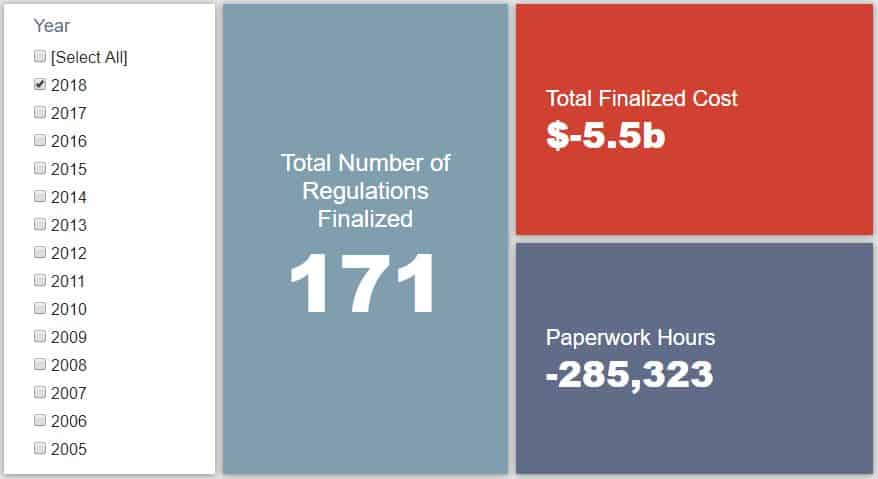Week in Regulation
August 6, 2018
A Steady Deregulatory Week
Last week’s rulemakings generally trended in the cost-reducing and paperwork-cutting direction. While 12 out of the 16 measures with quantified cost-benefit analysis were merely proposed rules, the Environmental Protection Agency (EPA) had a final rule that revised aspects of an Obama-era coal regulation. Between both proposed and final rules, agencies published roughly $628.9 million in net cost savings, and cut 1,675,822 hours of paperwork. The per capita regulatory burden for 2018 is negative $16.88.
Regulatory Toplines
- New Proposed Rules: 51
- New Final Rules: 60
- 2018 Total Pages of Regulation: 38,003
- 2018 Final Rules: -$5.5 Billion
- 2018 Proposed Rules: $12.9 Billion
Tracking Regulatory Modernization
The most significant rulemaking contributing savings towards the Executive Order (EO) 13,771 regulatory budget for Fiscal Year (FY) 2018 comes from EPA. This rule regarding “Hazardous and Solid Waste Management System: Disposal of Coal Combustion Residuals [CCR] From Electric Utilities; Amendments to the National Minimum Criteria” finalizes particular revisions to Obama-era CCR regulations. EPA estimates that this action could bring up to $31.4 million in annualized savings and $605 million over its lifetime. Affected entities could expect even further cost reductions in the future as other proposed changes become final.
According to American Action Forum (AAF) analysis, since the start of FY 2018 (beginning Oct. 1, 2017), executive agencies have promulgated 47 deregulatory actions with quantified estimates against 10 regulatory measures, under the rubric created by EO 13,771 and the administration’s subsequent guidance document on the matter. These rules combine for net annual savings of roughly $1.3 billion. This means that agencies have thus far surpassed the administration’s cumulative goal for FY 2018 of $687 million in net annual savings. In fact, according to the administration’s latest Unified Agenda, agencies are on track to roughly double that goal.
Click here to view AAF’s examination of the administration’s progress under the “one-in, two-out” executive order through the end of Fiscal Year 2017.
State of Major Obama-Era Initiatives
There was one notable regulatory action related to the Affordable Care Act (ACA). The administration’s rulemaking on “Short-Term, Limited-Duration Insurance” went final last week. The rule would extend the allowable coverage period for short term, limited duration (STLD) plans from three months to one year with the option to renew such plans for up to three years. As AAF’s Christopher Holt notes, “these changes represent a responsibly measured effort by the administration to help uninsured individuals for whom the ACA doesn’t provide a particularly viable option.” The agencies involved provided qualitative analysis of the measure’s costs and benefits.
Based on total lifetime costs of the regulations, the ACA has imposed costs of $52.9 billion in final state and private-sector burdens and 176.9 million annual paperwork hours.
Since passage, the Dodd-Frank financial reform legislation has produced more than 82.9 million final paperwork burden hours and imposed $38.9 billion in direct compliance costs.
Total Burdens
Since January 1, the federal government has published $7.4 billion in net costs (despite $5.5 billion in net savings from final rules) and paperwork burden cuts amounting to 748,255 hours (including 285,323 hours of paperwork reduced under final rules). Click here for the latest Reg Rodeo findings.











